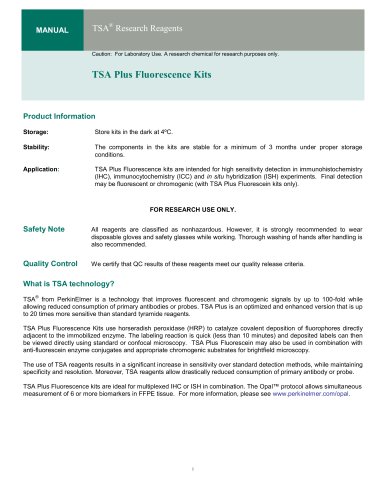
Catalog excerpts

TSA® Research Reagents Caution: For Laboratory Use. A research chemical for research purposes only. TSA Plus Fluorescence Kits Product Information Storage: Store kits in the dark at 4ºC. The components in the kits are stable for a minimum of 3 months under proper storage conditions. TSA Plus Fluorescence kits are intended for high sensitivity detection in immunohistochemistry (IHC), immunocytochemistry (ICC) and in situ hybridization (ISH) experiments. Final detection may be fluorescent or chromogenic (with TSA Plus Fluorescein kits only). Safety Note All reagents are classified as nonhazardous. However, it is strongly recommended to wear disposable gloves and safety glasses while working. Thorough washing of hands after handling is also recommended. Quality Control We certify that QC results of these reagents meet our quality release criteria. TSA from PerkinElmer is a technology that improves fluorescent and chromogenic signals by up to 100-fold while allowing reduced consumption of primary antibodies or probes. TSA Plus is an optimized and enhanced version that is up to 20 times more sensitive than standard tyramide reagents. TSA Plus Fluorescence Kits use horseradish peroxidase (HRP) to catalyze covalent deposition of fluorophores directly adjacent to the immobilized enzyme. The labeling reaction is quick (less than 10 minutes) and deposited labels can then be viewed directly using standard or confocal microscopy. TSA Plus Fluorescein may also be used in combination with anti-fluorescein enzyme conjugates and appropriate chromogenic substrates for brightfield microscopy. The use of TSA reagents results in a significant increase in sensitivity over standard detection methods, while maintaining specificity and resolution. Moreover, TSA reagents allow drastically reduced consumption of primary antibody or probe. TSA Plus Fluorescence kits are ideal for multiplexed IHC or ISH in combination. The Opal™ protocol allows simultaneous measurement of 6 or more biomarkers in FFPE tissue. For more information, please see www.perkinelmer.com/opal.
Open the catalog to page 1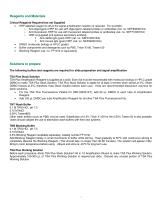
Reagents and Materials Critical Reagents Required but not Supplied HRP-labelled reagent to drive the signal amplification reaction is required. For example: o Anti-digoxigenin-HRP for use with digoxigenin labeled probes or antibodies (cat. no. NEF832001EA) o Anti-fluorescein-HRP for use with fluorescein labeled probes or antibodies (cat. no. NEF710001EA) o HRP-conjugated anti-species secondary antibody Anti-rabbit IgG (goat) HRP (cat. no. NEF812001EA) Anti-mouse IgG (goat) HRP (cat. no. NEF822001EA) DMSO (molecular biology or HPLC grade) Buffer components and detergents such as...
Open the catalog to page 3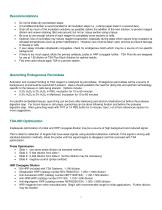
Do not let slides dry out between steps. A humidified chamber is recommended for all incubation steps (i.e., a damp paper towel in a covered box). Drain off as much of the incubation solutions as possible, before the addition of the next solution, to prevent reagent dilution and uneven staining. Blot area around, but not on, tissue section using a tissue. Be sure to use enough volume of each reagent to completely cover sections or cells. Optional: Use of coverslips may reduce reagent evaporation, especially during steps which require long incubation at elevated temperatures (such as probe...
Open the catalog to page 4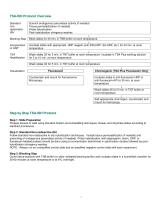
TSA-ISH Protocol Overview Standard nonradiometric ISH Blocking Step Incorporation of HRP TSA Amplification Quench endogenous peroxidase activity (if needed) Tissue permeabilization (if needed) Probe hybridization Post-hybridization stringency washes ↓ Block slides for 30 min. in TNB buffer at room temperature ↓ Incubate slides with appropriate HRP reagent (anti-DIG-HRP, SA-HRP, etc.) for 30 min. at room temperature ↓ Wash slides 3X for 5 min. in TNT buffer at room temperature Incubate in TSA Plus working solution for 3 to 10 min. at room temperature ↓ Wash slides 3X for 5 min. in TNT buffer...
Open the catalog to page 5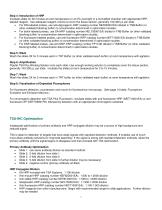
Step 4: Introduction of HRP Incubate slides for 30 minutes at room temperature or at 4ºC overnight in a humidified chamber with appropriate HRPlabeled reagent. Use adequate reagent volume to cover the tissue section, generally 100-300 µL per slide. For DIG-labeled probes, use anti-digoxigenin-HRP (catalog number NEF832001EA) diluted in TNB Buffer (or other validated blocking buffer) to concentration determined in optimization studies. For biotin-labeled probes, use SA-HRP (catalog number NEL750001EA) diluted in TNB Buffer (or other validated blocking buffer) to concentration determined...
Open the catalog to page 6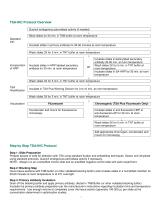
TSA-IHC Protocol Overview Quench endogenous peroxidase activity (if needed) ↓ Block slides for 30 min. in TNB buffer at room temperature Standard IHC ↓ Incubate slides in primary antibody for 30-60 minutes at room temperature ↓ Wash slides 3X for 5 min. in TNT buffer at room temperature ↓ Incubate slides in biotinylated secondary antibody 30-60 min. at room temperature Incubate slides in HRP labeled secondary Wash slides 3X for 5 min. in TNT buffer at or antibody for 30 min. at room temperature room temperature Incubate slides in SA-HRP for 30 min. at room temperature ↓ Wash slides 3X for 5...
Open the catalog to page 7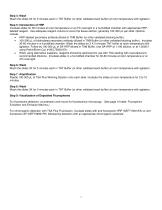
Step 4: Wash Wash the slides 3X for 5 minutes each in TNT Buffer (or other validated wash buffer) at room temperature with agitation. Step 5: Introduction of HRP Incubate slides for 30 minutes at room temperature or at 4ºC overnight in a humidified chamber with appropriate HRPlabeled reagent. Use adequate reagent volume to cover the tissue section, generally 100-300 µL per slide. Options include. HRP labeled secondary antibody diluted in TNB Buffer (or other validated blocking buffer). 100-300 µL of biotinylated secondary antibody diluted in TNB Buffer (or other validated blocking...
Open the catalog to page 8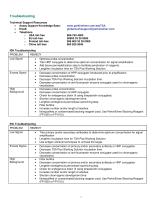
Technical Support Resources • Assay Support Knowledge Base: www.perkinelmer.com/askTSA • Email: global.techsupport@perkinelmer.com
Open the catalog to page 9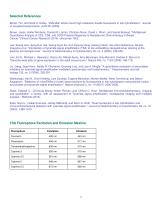
Brend, Tim, and Scott A. Holley. "Zebrafish whole mount high-resolution double fluorescent in situ hybridization." Journal of visualized experiments: JoVE 25 (2009). Brown, Jason, Hallie Wimberly, Donald R. Lannin, Christian Nixon, David L. Rimm, and Veerle Bossuyt. "Multiplexed Quantitative Analysis of CD3, CD8, and CD20 Predicts Response to Neoadjuvant Chemotherapy in Breast Cancer."Clinical Cancer Research (2014): clincanres-1622. Lee, Seung-won, Song Eun Lee, Seong Hyuk Ko, Eun Kyoung Hong, Kwang Il Nam, Kei-ichiro Nakamura, Shuhei Imayama et al. "Introduction of tyramide signal...
Open the catalog to page 10All Akoya Biosciences catalogs and technical brochures
-
Opal Storage and Stability
2 Pages
-
Anti-Hu Ki67
2 Pages

